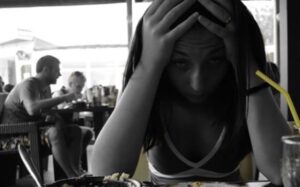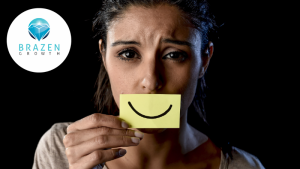Rigid rules around diet and exercise, which often form unhealthy behaviours follow rigid thoughts and beliefs we have of ourselves. In order to promote healthier habits, these rigid thought sets need to change.
We need to become more ‘flexible’ and not be so hard on ourselves. When I suffered anorexia, the fear to eat normally was huge as I thought I was a failure if I did. It was a very irrational thought yet created great fear. These thoughts lead to very ‘black and white’ thinking, becoming a ‘destructive normal pattern’ making change seem difficult to achieve. However, this thinking is ironic, as we think our rigid rule keeping will bring the change that we want, yet change in itself involves allowing flexibility.
I liken the trap of rigid thinking to a quote from the movie Shawshank Redemption:
“These walls are funny. First, you hate ’em, then you get used to ’em. Enough time passes, you get so you depend on them.”
Rigid Self Talk = Rigid Rules
Our self-talk can become a complex trap of comparing, criticising, judging and punishing ourselves. The behaviours of restricted dieting, excessive exercise, binging, purging and other compensatory behaviours can be a result of these thoughts and are a means of controlling the emotions that are unpleasant.
If our thoughts are automatic and govern rigid behaviour around food and exercise, then they become patterns of living we depend on. These create a fear and anxiety within us if we break these rules. There is no freedom to live fully when we are bound by this kind of rigidity.
Externalising the Problem
I have mentioned this before, but one of the best changes in my self-talk was to not call it ‘my eating disorder’. I refer to it now as ‘the eating disorder’. This creates distance so that the person can begin to see that they personally are not the problem. It allows for discernment of other factors that influence the thoughts and behaviours. It gives a sense of relief and hope that the individual is not worthless and helps develop skills to dealing with the factors rather than self-blame and punishment. Once the problem is externalised then the harmful thoughts can be examined.
Cognitive Fusion
Fusion is the joining of two or more things, so cognitive fusion occurs when we attach our thoughts or feelings to something. It may be a movie line, a song, a poem or the storyline of a book that reminds us of an event. Memories can come flooding back and we may have streams of thoughts, feelings, and sensations. At this time, they become our truth or rules that we feel we must obey.
The idea of cognitive fusion shows the need to become assertive in our thoughts and challenge these. The sooner this is done the more flexible we become and able to live in the present and not be driven to act automatically with unhealthy behaviours. The anxiety caused if rigid dieting is broken is immense. Negative thoughts scream in your mind about the failure that you are and that you are dirty and no longer worthy. Compensatory behaviours like excessive exercise, purging, and severe food restrictions are automatic and the cycle starts again.

Cognitive Defusion
Defusion is the opposite of fusion and involves stepping back and creating distance. Cognitive defusion creates distance between our thoughts, feelings, and beliefs to an event or experience. Defusion is the first step to take to help analyse thoughts in a healthy manner, seeing them as a stream of words, images, and sounds in our mind. Defusing these thoughts, or creating this distance takes time, however, they eventually have less impact.
A study by Trindade and Ferreira 1, revealed that body-image related cognitive fusion was positively associated with more general cognitive fusion. That means that thoughts are so automatic that certain events trigger automatic behaviour based on these. This shows that the person has lost the ability to be present, socially, physically and psychologically. The study also showed that cognitive fusion regarding body image was linked with unfavourable social rank perceptions. This could be a risk factor for developing an eating disorder or a consequence of having an eating disorder, where submissive behaviour dominates over assertive behaviour.
My personal experience reflects the results of this study. I did not know how to be assertive as I felt I was not allowed to have an opinion. Therefore, I felt unworthy and unloved. Over time, I became submissive as an attempt to please others. I became submissive in my self-talk and thought life. And so the cycle of attempting to make myself ‘feel better’ with unhealthy, rigid diet and exercise behaviours began. Thoughts about my body-image became rigid. The heightened anxiety would not allow for reflection of the present. You can read more about the effect of anxiety on our ability to identify emotion here
Holistic Treatment
Treatment for eating disorders needs to include challenging and replacing thoughts of low self-worth. Treatment needs to be holistic as eating disorders are complex and involve both unhealthy thoughts and behaviours that have negative mental, physical and social health consequences. To treat only the physical symptoms will not be effective in the long term. To get medical, professional help please visit any one of the organisations below or feel free to contact Eleni as a starting point at info@brazengrowth.com.au
If you or anyone you know is suffering from an eating disorder, then do not hesitate to seek help. Some great resources are:
- Inside Out Institute for Eating Disorders
- Eating Disorders Victoria
- The National Eating Disorder Collaboration
- The Butterfly Foundation
- Shape Your Mind Psychologists
Sources:
- Trindade, Inês A., and Cláudia Ferreira. “The impact of body image-related cognitive fusion on eating psychopathology.” Eating behaviors 15.1 (2014): 72-75.



